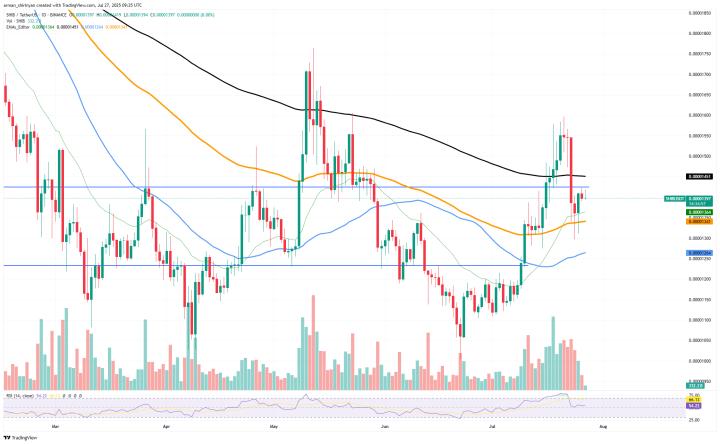Yesterday's article 《BTC Advances to Master Tournament》 cycle overlay cloud chart shows that the current bull market cycle is on track. However, from a different perspective, some anomalies become apparent.
This perspective is from gold - measuring BTC's value fluctuations based on the gold standard. As shown in the following image.

From the chart, it's obviously visible that since this bull market cycle, something has been slightly off after entering 2025. Why has the red line representing this cycle's price been softening, firmly pressed against the power law support line, forced to "fly close to the ground"?
The only thing to blame is gold's strong surge while BTC was horizontally consolidating at high levels!

Gold's unprecedented strong performance in the past 5 years means that despite BTC reaching new highs, when priced in gold, it is essentially just on par with the "1 BTC = 1 kg gold" valuation from the 2021 bull market Double Top.
A simple calculation:
Current gold price: $3,364/ounce
Current BTC price: $117,000
Known: 1 troy ounce = 0.0311034768 kg
Calculation: 1 kg gold price is $3,364 / 0.0311034768 = $108,155
It can be seen that BTC has just begun to break through the value suppression of 1 kg of gold.
Now BTC's height of $120,000 is roughly about twice the 2021 bull market high of over $60,000.
This means that over the past 5 years, the US dollar has depreciated by half, while both gold and BTC have maintained their value.
This is value storage (SoV).
BTC's surpassing of gold has just begun. Looking at the long-term, BTC's historical growth potential is clearly far beyond gold.

When He Yi wrote 《Bitcoin History》 in 2020, in Chapter 10, Story 40, he had already written:
"2019 was the connection point from the recession period to the depression period of the fifth Kondratieff cycle. In the depression period, the method to counter asset shrinkage is defense, shifting from aggressive assets (like stocks) to defensive value-preserving assets (like gold)."
At that time, gold was less than $2,000 per ounce, and now it has exceeded $3,300.

The 30-year long-term bond yields of the US and UK also basically bottomed out in 2020-2021. Since then, they have dramatically risen.

The surge in long-term bond rates means what? The surface reason is bond holder selling, but essentially it means a dramatic decline in national sovereign credit! Remember, yield is just a hedge against default risk.
In the balance sheet of modern central banks operating under MMT (Modern Monetary Theory), long-term government bonds are the backing assets for sovereign fiat currency.
Sovereign default may not be in the dramatic form of refusing to pay interest, but more likely in the "boiling frog" form of currency depreciation.
In other words, the surge in long-term bond rates means global bond buyers are voting with their feet, decisively opposing the high likelihood that these countries will not be able to constrain fiscal discipline and monetary policy in the future, thereby conducting an undeclared default through excessive money printing.
Selling these national debts, what you get is still the country's fiat currency, right? Isn't this currency another form of these debt assets? It's just changing the soup but not the medicine.
Therefore, ultimately, liquidity exit is still necessary. Exit to where? To true value storage. To real assets. To gold. To BTC.
...
On Tuesday, BTC surged to $123k overnight before falling back to $119k for correction. USDT 7.15, USD/CNH 7.17. The US dollar index stands above 98 points. Gold oscillates around $3,348.
Continuing trade uncertainties continue to suppress market sentiment. ... This issue's internal reference is about 3,000 words, mainly covering: market dynamics, macroeconomic conditions, reserve positions, new leverage highs, strictest regulations, long and tedious processes, quasi-stablecoins, retail investor divergence, etc. Click the title to continue reading 7.15 He Yi's internal reference 《Retail Investors Lose Chips》...







